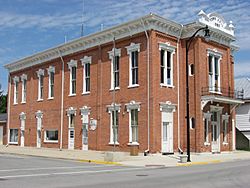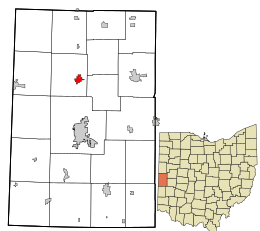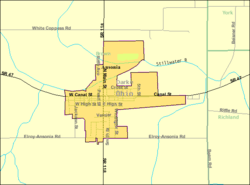Ansonia, Ohio facts for kids
Quick facts for kids
Ansonia, Ohio
|
|
|---|---|
|
Village
|
|

Brown Township Building in downtown Ansonia
|
|

Location in Darke County and the state of Ohio.
|
|

Detailed map of Ansonia
|
|
| Country | United States |
| State | Ohio |
| County | Darke |
| Township | Brown |
| Area | |
| • Total | 0.67 sq mi (1.73 km2) |
| • Land | 0.65 sq mi (1.68 km2) |
| • Water | 0.02 sq mi (0.05 km2) |
| Elevation | 1,001 ft (305 m) |
| Population
(2020)
|
|
| • Total | 1,160 |
| • Estimate
(2023)
|
1,149 |
| • Density | 1,792.89/sq mi (691.83/km2) |
| Time zone | UTC-5 (Eastern (EST)) |
| • Summer (DST) | UTC-4 (EDT) |
| ZIP code |
45303
|
| Area codes | 937, 326 |
| FIPS code | 39-02120 |
| GNIS feature ID | 2397968 |
Ansonia is a small village located in Darke County, Ohio, in the United States. In 2020, about 1,160 people lived there.
Contents
History of Ansonia
Ansonia was started in 1845. It was first called "Dallas." The village grew slowly at first. A big change happened when a railroad arrived in 1852.
The area around Ansonia had many swamps. This meant there was a lot of woodland nearby. Because of this, Ansonia became a place where many products were made from hardwood.
In 1873, the people of Ansonia built a new, large two-story school. It cost ten thousand dollars. This building was the first home for Ansonia High School, which began that same year. The 1873 school was later taken down. A new one was built in its place in 1903.
Another important building in the village was a mausoleum. This special building, made of marble, was built in 1911. It was the first mausoleum in all of Darke County.
In its early years, Ansonia had many community groups. These groups helped people connect and work together. For example, a group called the Masons started in 1874 with sixteen members. Over the next forty years, this group grew much larger. Another group, the Odd Fellows, began in 1875. It also started with sixteen members and grew a lot. Women in the village also formed a group called the Daughters of Rebekah in 1894. The Knights of Pythias, another community group, was also started in Ansonia in 1889. These groups showed how people in Ansonia came together to build their community.
Geography of Ansonia
Ansonia is a small village. It covers about 0.67 square miles (1.73 square kilometers). Most of this area is land, with a small part being water.
The village is located about six miles north of Greenville. Greenville is the main town, or county seat, of Darke County.
People of Ansonia
| Historical population | |||
|---|---|---|---|
| Census | Pop. | %± | |
| 1880 | 542 | — | |
| 1890 | 676 | 24.7% | |
| 1900 | 676 | 0.0% | |
| 1910 | 656 | −3.0% | |
| 1920 | 807 | 23.0% | |
| 1930 | 651 | −19.3% | |
| 1940 | 712 | 9.4% | |
| 1950 | 877 | 23.2% | |
| 1960 | 1,002 | 14.3% | |
| 1970 | 1,044 | 4.2% | |
| 1980 | 1,267 | 21.4% | |
| 1990 | 1,279 | 0.9% | |
| 2000 | 1,145 | −10.5% | |
| 2010 | 1,174 | 2.5% | |
| 2020 | 1,160 | −1.2% | |
| 2023 (est.) | 1,149 | −2.1% | |
| U.S. Decennial Census | |||
Ansonia Population in 2010
In 2010, there were 1,174 people living in Ansonia. These people lived in 448 households. About 322 of these households were families.
Most people living in Ansonia were White (98.8%). A small number of people were from other backgrounds. About 1.6% of the population was Hispanic or Latino.
Many households (37.5%) had children under 18 living with them. Half of the households (50%) were married couples living together. Some households had a single parent. About 21.9% of all households had just one person living there.
The average age of people in Ansonia was 35.4 years old. About 27.6% of residents were under 18. About 10.3% were 65 years old or older. The village had slightly more females (51.5%) than males (48.5%).
See also
 In Spanish: Ansonia (Ohio) para niños
In Spanish: Ansonia (Ohio) para niños

